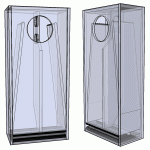Demetri is a folded ML-Voigt designed originally for the FE207 and then tweaked to support FF225wk (which really needs help up top).
Similar designs are very likely doable for drivers that have already been fitted to a TL of some sort. The Voigt a big box designed to work towards maximizing bottom.
Related, i have a set of Mileva (smaller Demetri) cabinets for give-away (you have to come pick them up) and was starting to look at available drivers that could work in it.
dave
Hi Dave, the Demitri also worked ok years ago for the Hemp Acoustics FR8 driver right?
So do you think it would work for the similarly spec'ed SB Acoustics SB20FRPC30-8 ?
Know where the cabinet design/plans is, I can't find it?
Also what affect does this wide baffle design make to the sound versus the more traditional narrow and deep cabinets? thanks!
edit: I just noticed another similarly wide but shallow TL design for the FR8C here.
This would also work for the SB FR 8"? or are there better alternatives?
Attachments
Last edited:
Geez, now that I search for FR8C cabinets I see more and more options, like this Half-Chang and this Metronome.
I'm guessing there are dozens of options? how to decide....🤔
I'm guessing there are dozens of options? how to decide....🤔
Last edited by a moderator:
What effect does the wide baffle format have on the sound? Wide and shallow like the Demetri vs narrow and deep?
Do you know where the Demitri plans are?
Do you know where the Demitri plans are?
Lowers the transition point from 2∏ to 4∏ response at a lower frequencies and are typically used near the wall to the point where ther eis bo transition.
dave
dave
Last edited:
LOL that was Greek to me. 😆
I had to go read up on baffle step loss stuff n found your 2Pi 4Pi reference.
I had to go read up on baffle step loss stuff n found your 2Pi 4Pi reference.
wide baffles and baffle step
Lengthy quotation from Peter Comeau, designer at Wharfedale. Makes a lot of sense to me...
"Th[e] larger ported box, with its subsequent increased baffle size, helps solve a major problem in modern speakers, namely, the baffle step.
I grew up with large speakers with wide baffles, but, as speakers reduced in size over the years I noticed that something was missing from the sound and, when I stuck my head firmly into speaker design, I began to understand the acoustic problems caused by the baffle step.
Put simply, as the baffle size decreases, the point at which the acoustic radiation changes from hemispherical to spherical goes up in frequency. It also becomes sharper and narrower in bandwidth as the sides of the cabinet, and the walls and floor of the room, are further removed from the equation. So, this 6dB step in the power response becomes acoustically more obvious.
I believe that a thin speaker always sounds thinner throughout the midrange when directly compared to a speaker with more generous baffle width. Of course, as designers of modern, slim speakers, we compromise by adjusting for the baffle step in the crossover, but in doing so, we also compromise sensitivity. What starts out as a 90dB at 1W drive-unit often ends up as an 85dB system once we have adjusted for the power loss due to the baffle step."
"Yes, Harbeth, Spendor Classic, Graham, Yamaha, Devote, Audio Note, and plenty others all prove that a wide baffle can work exceptionally well. So it's clearly not as simple as either/or. In fact, I suspect my preference for many of these designs has something to do with precisely that feature."
Last edited:
